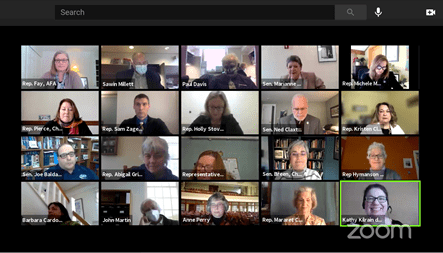The word “unprecedented” has been used on almost a daily basis since March 17th of last year, however I use it again today because low-income Mainers are facing an unprecedented intersection of crises that they cannot weather without your help. Sweeping unallocated funds from basic needs programs like SNAP, MaineCare, ASPIRE, TANF and General Assistance that have always carried over to meet the need in future years eliminates needed flexibility when technology, or simple things like rulemakings, require additional funds.
– Kathy Kilrain del Rio
Kathy Kilrain del Rio, Director of Campaigns & Healthcare Advocacy for Maine Equal Justice, submitted the following testimony "neither for nor against" LD 221, the state's budget for the next two years:

Helpful links:
- View the Appropriations and Financial Affairs Committee hearing for LD 221
- Maine Equal Justice fact sheet: The State of Poverty in Maine 2021
Good morning Senator Breen, Senator Claxton, Representative Pierce, Representative Meyer, members of the Appropriations and Financial Affairs Committee, and members of the Health and Human Services Committee. My name is Kathy Kilrain del Rio. I’m the Director of Campaigns and Health Care Advocacy for Maine Equal Justice, a nonprofit legal aid provider working to increase economic security, opportunity, and equity for people in Maine. I’m testifying Neither for Nor Against LD 221 to ask that you strengthen this biennial budget by making stronger investments to address the longstanding issues of poverty, hunger, housing, health, and income-insecurity—all of which have been exacerbated by COVID-19, and without bold and deliberate action, will continue to leave many Mainers behind once the pandemic has passed and our economy recovers.
The biennial budget is an opportunity for our state to invest in economic security programs for all Mainers in need and to target racial disparities in health care access, economic stability, and opportunity to ensure equity for Black, Indigenous, and people of color in Maine. Those investments would strengthen our communities and our state economy.
Our organization works directly with low-income people to help them navigate systems that can help them meet the basic needs of themselves and their families. We also work together to identify solutions to poverty that can help move low-income people from crisis to security. As you might imagine, the past year has seen the need for our legal aid grow and highlighted the challenges faced by low-income people for many Mainers who hadn’t previously experienced financial insecurity.
The pandemic and recession have exacerbated existing economic inequality and racial disparities that already made hunger, housing insecurity, and financial hardship the reality for too many Mainers. It is widely recognized that low-wage, Black, and women workers, including many single parents, bore the brunt of pandemic-related job loss as those losses centered on industries where they are disproportionately employed—health care, retail, hospitality, and personal services industries. Yet even before the pandemic many of these workers needed access to a strong safety net and will again once the labor market starts to recover, due to low wages, and the prevalence of irregular and undependable hours in many of these industries coupled with difficulties related to lack of benefits, child care, and reliable transportation.
To give you a better sense of the challenges facing many low-income Mainers, I’ve included an informational piece about poverty in Maine. A few highlights to keep in mind:
- One in eight adults and one in five children are unable to get enough food each day.[1]
- Nearly 60% of extremely low-income households pay more than 50% of their income for rent.[2]
- The implementation of Medicaid expansion has been a critical safety net for more than 70,000 people in our state. However, nearly one in twelve Mainers still lack health coverage, including many of our families, friends, and neighbors who are immigrants with equally low incomes. Many other Mainers struggle to afford the cost of care even with insurance.[3]
- Even as health care professionals struggle to reduce unnecessary hospitalization to preserve resources and limit COVID exposure, hundreds of low-income Mainers with untreated dental pain and infection have no choice but to turn to the emergency room for care since Maine is one of only ten states providing only emergency dental services in its Medicaid program.
- Nearly one in three Maine adults are having trouble covering usual household expenses.[4]
For Mainers of color – especially those who are Black or Indigenous – the challenges are even worse. For example, the poverty rates for Black or Indigenous children in Maine are 46% and 44% respectively while it is 15% for white children. The pandemic and recession are also hitting those communities harder. Black communities in Maine have contracted COVID-19 at a rate more than 20 times that of white Mainers.[5] Black, Indigenous, and People of Color are more likely to be unemployed due to the pandemic, with Black workers more likely to experience longer periods of unemployment than white workers.[6] At the same time, workers of color are less likely than white workers to receive unemployment benefits for which they qualify.[7]
This data highlights why we urge you to look for opportunities to ensure this budget responds to the needs of low-income Mainers. For that reason, we are grateful to see a change to the MaineCare program that aligns our estate recovery program to the minimum federal Medicaid requirements, which only apply to services related to long-term care. This critical change will make it easier for Mainers ages 55-64 to enroll in MaineCare without fear that basic care or care for conditions like cancer, diabetes, heart disease, or even COVID will leave them without a house or family property to leave their families when they die.
But there is so much more to do. The word “unprecedented” has been used on almost a daily basis since March 17th of last year, however I use it again today because low-income Mainers are facing an unprecedented intersection of crises that they cannot weather without your help. Sweeping unallocated funds from basic needs programs like SNAP, MaineCare, ASPIRE, TANF and General Assistance that have always carried over to meet the need in future years eliminates needed flexibility when technology, or simple things like rulemakings, require additional funds.
Investing in housing supports, health care, the unemployment insurance system, and public health infrastructure for communities of color will result in greater financial security and improved health for thousands of Mainers over time. These investments not only help meet the immediate needs of those struggling the most, they support our local and state economies where low-income people spend their money on rent, child care, and groceries – and where they get their health care from local providers. Furthermore, these investments result in long-term health and educational improvements for adult and children[1] – children who are Maine’s future.
You’re hearing about some of those needs this week and others will come forward as bills move through the legislative process. Please remember that behind each of the statistics I’ve shared with you today are the faces of your neighbors, your friends, and maybe even your family who are wading through a flood of loss, uncertainty, and trauma. For their sake – and for the economic security of us all – this budget needs to direct more resources to those struggling the most, to look beyond COVID to begin to tackle the chronic, longstanding problems too many Mainer’s face, and begin to address the systemic inequities that are being worsened during these crises.
[1] https://www.feedingamerica.org/hunger-in-america/maine
[2] https://nlihc.org/housing-needs-by-state/maine
[3] https://www.k.org/other/state-indicator/total-population/?currentTimeframe=0&selectedRows=%7B%22states%22:%7B%22maine%22:%7B %7D%7D%7D&sortModel=%7B%22colId%22:%22Location%22,%22sort%22:%22asc%2
[4] https://www.cbpp.org/research/poverty-and-inequality/tracking-the-covid-19-recessions-effects-on-food-housing-and
[5] Miller, K. (2020, June 22). Maine has nation’s worst COVID-19 racial disparity. Portland Press Herald. Retrieved November 30, 2020 from https://www.pressherald.com/2020/06/21/maine-has-nations-worst-covid-19-racial-disparity/
[6] Williams, J. (2020, September 29) Laid O More, Hired Less: Black Workers in the COVID-19 Recession. The Rand Blog. Retrieved November 30, 2020 from: https://www.rand.org/blog/2020/09/laid-o-more-hired-less-black-workers-in-the-covid.html
[7] https://bipartisanpolicy.org/blog/survey-points-to-potential-racial-disparities-in-approval-rates-for-unemployment-insurance-claims/






 Maine Equal Justice focuses its work on many of the issues that affect people’s daily lives – access to adequate health care, housing, transportation and childcare; food and income security; and higher education and training. Maine Equal Justice is a 501 c 3 nonprofit organization. Our EIN is 04-3346273.
Maine Equal Justice focuses its work on many of the issues that affect people’s daily lives – access to adequate health care, housing, transportation and childcare; food and income security; and higher education and training. Maine Equal Justice is a 501 c 3 nonprofit organization. Our EIN is 04-3346273. 